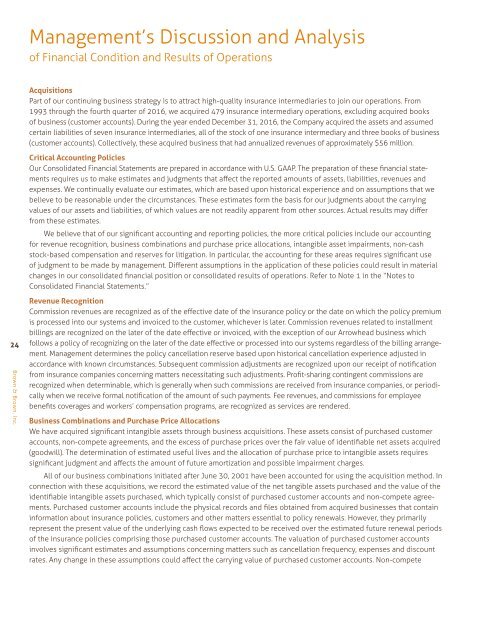Brown & Brown Insurance 2016 Annual Report
2016 Annual Report
2016 Annual Report
You also want an ePaper? Increase the reach of your titles
YUMPU automatically turns print PDFs into web optimized ePapers that Google loves.
Management’s Discussion and Analysis<br />
of Financial Condition and Results of Operations<br />
Acquisitions<br />
Part of our continuing business strategy is to attract high-quality insurance intermediaries to join our operations. From<br />
1993 through the fourth quarter of <strong>2016</strong>, we acquired 479 insurance intermediary operations, excluding acquired books<br />
of business (customer accounts). During the year ended December 31, <strong>2016</strong>, the Company acquired the assets and assumed<br />
certain liabilities of seven insurance intermediaries, all of the stock of one insurance intermediary and three books of business<br />
(customer accounts). Collectively, these acquired business that had annualized revenues of approximately $56 million.<br />
Critical Accounting Policies<br />
Our Consolidated Financial Statements are prepared in accordance with U.S. GAAP. The preparation of these financial statements<br />
requires us to make estimates and judgments that affect the reported amounts of assets, liabilities, revenues and<br />
expenses. We continually evaluate our estimates, which are based upon historical experience and on assumptions that we<br />
believe to be reasonable under the circumstances. These estimates form the basis for our judgments about the carrying<br />
values of our assets and liabilities, of which values are not readily apparent from other sources. Actual results may differ<br />
from these estimates.<br />
We believe that of our significant accounting and reporting policies, the more critical policies include our accounting<br />
for revenue recognition, business combinations and purchase price allocations, intangible asset impairments, non-cash<br />
stock-based compensation and reserves for litigation. In particular, the accounting for these areas requires significant use<br />
of judgment to be made by management. Different assumptions in the application of these policies could result in material<br />
changes in our consolidated financial position or consolidated results of operations. Refer to Note 1 in the “Notes to<br />
Consolidated Financial Statements.”<br />
24<br />
<strong>Brown</strong> & <strong>Brown</strong>, Inc.<br />
Revenue Recognition<br />
Commission revenues are recognized as of the effective date of the insurance policy or the date on which the policy premium<br />
is processed into our systems and invoiced to the customer, whichever is later. Commission revenues related to installment<br />
billings are recognized on the later of the date effective or invoiced, with the exception of our Arrowhead business which<br />
follows a policy of recognizing on the later of the date effective or processed into our systems regardless of the billing arrangement.<br />
Management determines the policy cancellation reserve based upon historical cancellation experience adjusted in<br />
accordance with known circumstances. Subsequent commission adjustments are recognized upon our receipt of notification<br />
from insurance companies concerning matters necessitating such adjustments. Profit-sharing contingent commissions are<br />
recognized when determinable, which is generally when such commissions are received from insurance companies, or periodically<br />
when we receive formal notification of the amount of such payments. Fee revenues, and commissions for employee<br />
benefits coverages and workers’ compensation programs, are recognized as services are rendered.<br />
Business Combinations and Purchase Price Allocations<br />
We have acquired significant intangible assets through business acquisitions. These assets consist of purchased customer<br />
accounts, non-compete agreements, and the excess of purchase prices over the fair value of identifiable net assets acquired<br />
(goodwill). The determination of estimated useful lives and the allocation of purchase price to intangible assets requires<br />
significant judgment and affects the amount of future amortization and possible impairment charges.<br />
All of our business combinations initiated after June 30, 2001 have been accounted for using the acquisition method. In<br />
connection with these acquisitions, we record the estimated value of the net tangible assets purchased and the value of the<br />
identifiable intangible assets purchased, which typically consist of purchased customer accounts and non-compete agreements.<br />
Purchased customer accounts include the physical records and files obtained from acquired businesses that contain<br />
information about insurance policies, customers and other matters essential to policy renewals. However, they primarily<br />
represent the present value of the underlying cash flows expected to be received over the estimated future renewal periods<br />
of the insurance policies comprising those purchased customer accounts. The valuation of purchased customer accounts<br />
involves significant estimates and assumptions concerning matters such as cancellation frequency, expenses and discount<br />
rates. Any change in these assumptions could affect the carrying value of purchased customer accounts. Non-compete


